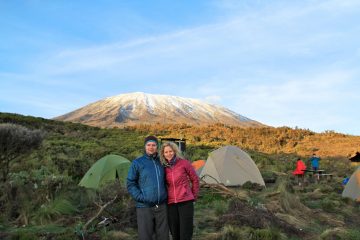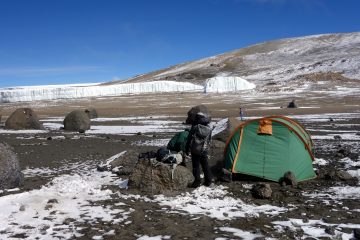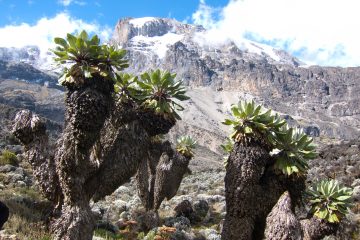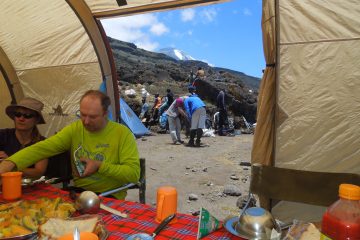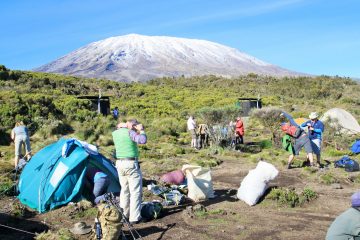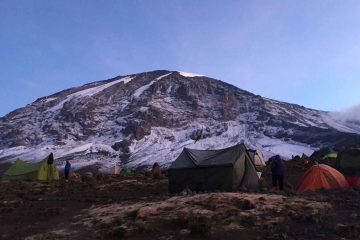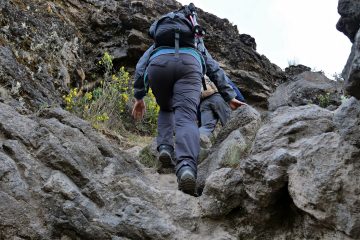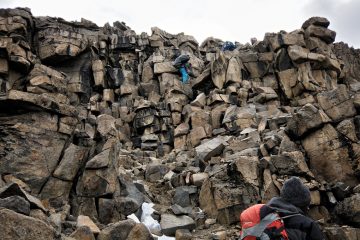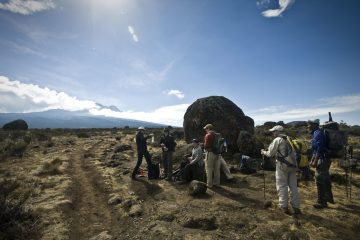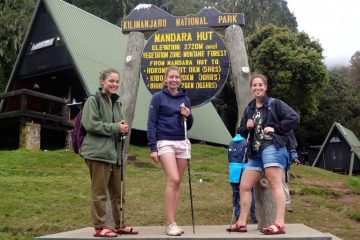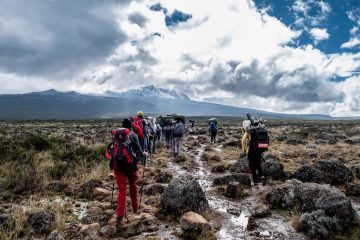What to consider when climbing Kilimanjaro
There are a number of aspects to consider when choosing the best time to come for your climb. Most of these key factors play a huge role in the outcome of your trip and summit success.
Weather Conditions
Because Kilimanjaro is so close to the equator, it doesn’t have the same four seasons as the rest of the globe. Instead, it has wet and dry seasons, which both change the appearance of the mountain.
The ideal months to climb Kilimanjaro are January to early March and June to October. Clear skies, beautiful views, and plenty of sunshine allow for fantastic photo possibilities and pleasant hiking conditions.
These are generally the driest and busiest months of the year.
Regardless of the season, though, the weather has the potential to change abruptly.
Read more about Kilimanjaro Weather
Temperature
As you climb higher up the mountain, temperatures change with the seasons and within the different climatic zones.
The summit zone is classified as “Arctic,” with temperatures consistently below freezing throughout the year.
The coldest months are generally December through March and June (right after the rains), and there’s a strong possibility you’ll see snow on the top. As a result, the number of visits is reduced (as compared to July through August which is the busiest time).
Visibility issues: Mist, Fog and Cloud cover
You didn’t travel all this way to walk through fog and gloomy sky. Due to cloud cover, visibility can be low from late March until the end of May, and throughout November. You won’t be able to see the panoramic views, and you won’t be able to take good photographs.
Crowds: Number of climbers on Kilimanjaro and Traffic
The excellent weather in January through early March, and June through October, making the mountain busier as climbing Kilimanjaro becomes more popular.
The Marangu and Machame routes are generally the ones that are overcrowded. You may still enjoy the views without too many people if you choose one of the less popular routes, such as the Northern Circuits, Rongai, or Lemosho.
Overcrowding of toilet facilities at campsites is one of the primary drawbacks that climbers strive to avoid when trekking during peak seasons. We look after our climbers by providing private bathroom tents that are exclusively used by our group.
The sense of friendships and connections formed as a result of meeting other climbers more than compensates for the fact that it is a little “busy.” Many of our clients have formed lifetime bonds with others they met on the mountain.
When is the best time to climb Kilimanjaro without the crowds?
The off seasons, immediately before and after the rains, are the quietest times of year if you don’t mind getting wet and are properly equipped.
If you want to be alone, risking a little rain in exchange for having the mountain to yourself might be a fair trade-off.
During the rainy season (April/May and November), we avoid climbing.
Choose one of the routes with less foot traffic as an alternative. During the rainier months, we prefer the paths on the mountain’s northern side, which receive less rainfall and are more protected.
Safety and Trail Conditions
If you’re an experienced hiker, slick paths and a little mud might not bother you.
Climbing during the dry months is recommended for beginner hikers. Less rain equals less worry and pain, allowing you to spend more time relaxing and enjoying your surroundings.
The path may become fairly muddy on the lower slopes, through the forest, and higher up, slippery, rocky trails can be a problem.
We are highly concerned about your safety. Our guides are extremely knowledgeable and have climbed Kilimanjaro in all types of weather. We keep an eye on the weather and are adaptable enough to change the daily schedule if necessary.
If you become wet, your body is more likely to become severely cold. Your body is already dealing with the effects of altitude as you climb higher, and damp garments might be the difference between a mild cold and hypothermia.
It’s critical to keep your gear dry, prevent becoming soaked, and never linger in damp garments for your safety and comfort!
You’ll need some tough wet-weather clothing (which we recommend at any time of year), one of the less demanding itineraries, and waterproof bags for your stuff in both your daypack and duffel bag.
NB: Please note that the Tanzanian government has outlawed the usage of all plastic bags, so do not put your belongings in rubbish bags or Ziploc bags. Waterproof stuff sacks, such as these, are recommended.
Your Schedule
When deciding when to climb, consider what you want to do before and after your climb – perhaps a Tanzanian safari or a Zanzibar vacation – or simply when you can obtain time off work to go.
Apart from the wettest months (April and November), there is no such thing as a “bad” time to climb Kilimanjaro. There is no such thing as an “ideal” moment to climb. The weather on any mountain may be unexpected, which is all part of the fun.
To Full moon or not to Full Moon, that is the question
Consider the following scenario: a clear midnight sky lit by a full moon. You change into your summit gear, emerge from your tent, and gaze out the window at the majesty of the mountain you’re going to climb, illuminated by the moon. As you rise, you won’t even need your headlamp.
Climbing Kili under the light of a full moon is a beautiful experience. If crowds are an issue for you, keep this in mind while planning your trek around the full moon.
You’ll need to start your journey five days before the full moon date; for a seven-day trek, you’ll need to start five days before the full moon date. Keep in mind, though, that the night before and following the full moon will be as magnificent (and possibly quieter).
If the full moon makes you feel like a wolf and makes you howl, or if you have trouble sleeping with the light on, plan your dates around the New Moon. With less light, you can see the stars clearly and enjoy excellent stargazing.
Some people like to climb Kilimanjaro under a full moon since the nocturnal journey to the top is considerably easier. If that’s what you want, the full moon dates are shown above. Full moon dates are busier than other times of the month, which should come as no surprise. For astronomers, a full moon implies virtually no stars, whereas a new moon provides a very beautiful night sky.
See the full moon Kilimanjaro climbing dates, here.
So when is the best time to climb Kilimanjaro?
Kilimanjaro may be climbed all year, however, we recommend avoiding the long and brief rains (April-May and November) for your safety and comfort. If your schedule only permits you to trek during the shoulder seasons, we can accommodate you.
Finally, you should consider the cost of flights before deciding on the ideal time to climb Kilimanjaro. These fluctuate greatly throughout the year and are especially expensive during the major European holiday months, so if you want to save some money, avoid these months when you want to visit Tanzania to climb Kilimanjaro.
Month | Temperature | Precipitation | Cloudiness | Crowds |
| January | Warm | Medium | Low | High |
| February | Warm | Medium | Low | High |
| March | Moderate | High | Medium | Low |
| April | Moderate | High | High | Low |
| May | Moderate | High | High | Low |
| June | Cold | Medium | Medium | Medium |
| July | Cold | Medium | Low | High |
| August | Cold | Low | Low | High |
| September | Moderate | Low | Low | High |
| October | Moderate | Low | Medium | Medium |
| November | Moderate | High | Medium | Low |
| December | Moderate | Medium | Medium | Medium |
Recommended |
Good |
OK |
Not
Recommended |






